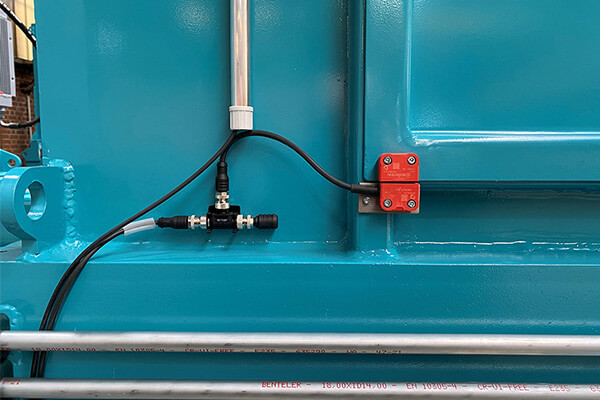45 million tonnes of waste are produced by Germans alone every year – if you were to load this amount into waste collection vehicles and place them one behind the other, they would reach once completely around the earth. As a mechanical engineering professional specialising in environmental technology, Ludden & Mennekes designs, constructs and implements systems for use in the waste disposal industry. For one of these, the company relied on smart safety technology and enlisted BERNSTEIN AG as a partner.
The application
The people responsible at Ludden & Mennekes see waste as a valuable raw material. In order to be able to recycle this raw material, sophisticated plant solutions are necessary, the development and implementation of which they are committed to. The stationary compaction plant of the KBW series, for example, offers such a solution. It is used where larger quantities of residual materials and recyclable raw materials are to be compacted before transport. This enables optimal utilisation of the permissible load of a transport vehicle and thus cost-effective transport. The system is suitable for compacting residual waste, commercial waste, green waste, film, paper and cardboard.
The safety technology
BERNSTEIN AG from Porta Westfalica assisted the manufacturer with the implementation of safetyrelated solutions for a smooth and safe compaction process. The company’s product portfolio ranges from switches, sensors and enclosures to suspension systems and operating terminals to system solutions for operating and safeguarding entire machines and plants.
Specifically, several contactless RFID safety sensors (SRF) are used at the compaction plant of the company Ludden & Mennekes. They take over the task of checking whether four different maintenance flaps are properly closed. If the SRF safety sensor determines that this is not the case, the system cannot be put into operation. In addition, the smart SRF sensors help to find the unlocked flap accordingly quickly in order to rectify the fault. This is because BERNSTEIN placed a special focus on the diagnostic system associated with the sensor during development: It reads a large amount of data and makes it available centrally and flexibly.
Another SRF safety sensor performs an extremely important function inside the compaction plant:“When the plant is restarted after a malfunction, it must be ensured that the compaction ram, which compacts the waste, returns to a safe position. This simple safety function prevents serious accidents and guarantees a defined start position so that the safety protocols function cleanly,” explains Robert Thesing (BERNSTEIN AG), who is the on-site contact for the Ludden & Mennekes managers. Checking whether the stamp has reached its safe position inside the system is also one of the tasks of a noncontact SRF safety sensor from BERNSTEIN.
The challenge
“In the case of the Ludden & Mennekes compaction plant, there was a requirement to integrate an external conveyor belt leading to the compaction plant as well as an emergency stop installed on it. Requirements of the Machinery Directive for a safety-related link were to be implemented. Finally, it is crucial that the conveyor belt and the compactor “work together” and that the current status of the other is known. If, for example, the conveyor belt is unstoppably conveying waste into the system, but the system is just not ready for operation because, for example, an SRF sensor has detected a malfunction, this is an unfavourable interaction that should be avoided at all costs,” Robert Thesing explains the challenge for BERNSTEIN.
The solution
But even for this, those responsible found an individual customer solution. Among other things, the BERNSTEIN SCR P evaluation provides a remedy. Where as many as 8 safety relays were previously used in the compaction plant, the SCR P alone now replaces a total of 6. Two more remain for the conveyor belt and the emergency stop installed on it. “On the one hand, costs for hardware can be saved with the SCR P.
On the other hand, the wiring effort for the customers is considerably lower, which saves a lot of time. By combining several safety relays in one device, the SCR P takes up significantly less space in the control cabinet. Thanks to the intuitively operable software, programming is no problem at all for the user,” explains Robert Thesing.
Of course, diagnostic data also play an important role in the SCR P. They are made available to the user via Ethernet protocol. “We see ourselves as a solution provider and provide our customers with scalable electronic safety solutions. Depending on the application and requirements, different components can be combined and in the end form a SMART Safety System that is perfectly tailored to individual needs. During the development of the system, special emphasis was placed on the patented DCD diagnostic system, which provides comprehensive data of each connected device and thus makes each machine SMART,” Robert Thesing explains BERNSTEIN AG’s approach.

